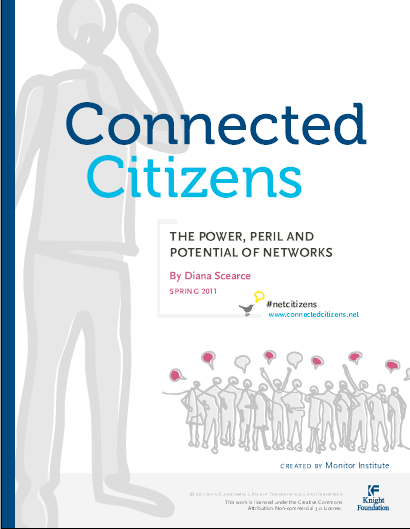
Seven ways to civic engagement: Insights from Detroit and beyond
Earlier this year, thought leaders in Detroit and nationally gathered to exchange ideas for bringing people together in our increasingly connected world.
One of the best examples was organic: once a year, residents of Detroit’s Midtown neighborhood gather for the Marche du Nain Rouge, a mini-Mardi Gras where residents can put on costumes and send the “red dwarf of Detroit” – said to have cursed the city for centuries – back from whence he came.
No chamber of commerce dreamed up the event that helps strengthen the neighborhood. It bubbled up from the people, and serves as a reminder that while the goals of community engagement may be high-minded and serious, the road there may be motivated by, joyfulness and fun.
This was one of the insights from the Detroit Civic Engagement Showcase & Learning Conference, a TED-style learning event organized by Knight Foundation and Philanthropy for Active Civic Engagement (PACE).
Detroit, with its growing community of social entrepreneurs, proved a perfect setting for a morning of reflection on the best ways to bring communities together around important issues.
The themes and lessons within, though, will resonate with any community searching for new ways to help residents shape their collective future.
Here are seven of the insights gleaned from the morning – and included in the new report, Connected Citizens Detroit: A Snapshot of Civic Engagement, written by the Center for Michigan: Related REPORTS


1) Presume people want to be engaged
Martha McCoy of the national organization Everyday Democracy, works to create communities where everyone is included in public problem solving. One thing she has learned is that you have to start by assuming people want to be involved. “That is part of what it means to be human,” McCoy said. “We care about the things that affect our lives.”
2) Recognize
One key way to engage more people is to recognize the work they are already doing, said Darryl Redmond. He served as a project coordinator for BMe, a growing network of black men working to strengthen their communities. BMe works by recognizing men for their everyday community actions, and having them tell their stories on video at bmecommunity.org.
Recognizing their work motivates them even more, and inspires others to be like them. “Everyone has a personal story,” Redmond said. “When you see what they’re passionate about, you can engage them. If there is no passion, there is not engagement.”
3) Leverage the power of networks
Elizabeth Garlow, of Michigan Corps, Trish Dewald of the Coalition on Temporary Shelter (COTS) and Delphia Simmons, of Thrive Detroit spoke of the importance of making connections between people and their networks, as well as breaking big problems into small pieces.
In the Michigan Corps initiative Detroit4Detroit, for example, citizen philanthropists find projects they find compelling, then use the website to reach out to friends and colleagues in their own networks to raise funds. Since the program was initiated in June 2012, 150 citizen philanthropists have contributed $67,000 to 85 Detroit4Detroit projects.
4) Use the digital tools at your disposal
Andrew Rasiej, who leads the Personal Democracy Forum, offered the observation that when Facebook made organ donation a priority, it asked users to state their donor status on their profiles. The response was overwhelming positive. What would happen, he asked, if we all registered our blood types as well – and during a shortage, potential donors could be asked to make an appointment online? The lesson here is to think of ways to employ the social networks we use daily, in new ways, to a greater end.
5) Try a game
Dan Pitera and Priya Iyer used an online game called Community PlanIt to draw Detroiters into a conversation about planning for their city’s future. The platform lured players into tackling “missions” through completing challenges that put them in an urban planner’s shoes. The effort drew a crucial demographic – young people – into the planning process. More than 1,000 registered players gave the game a try and left 8,400 comments.
6) Make sure it works
Vince Keenan started Publius.org in 1996 as a simple website that allowed people to find their polling locations and see sample ballots. Six years later, it was named a model template for voting information by the Federal Election Commission. He compared good government engagement systems to something we use every day – a toilet. How so? “It’s a community good. We don’t really know how it works. It becomes a problem when it doesn’t work. When it doesn’t work, you have to deal with people who want to tell you more than you want to know.”
7) Don’t forget the fun.
Jerry Paffendorf has been behind a number of innovative websites in Detroit, but he made national news with his crowdfunded effort to privately fund a statue of Robocop, Detroit’s fictional cinematic crime fighter. “All hell broke loose, in good ways and bad ways,” Paffendorf said, in a clash of “high-pressure and low-pressure fronts of lovers and haters.”
Through Kickstarter, he raised $50,000.
The statue is still under construction, but the lesson was learned: Don’t underestimate the Internet public.
Dig deeper into the insights by reading the report Connected Citizens Detroit: A Snapshot of Civic Engagement
By Nancy Derringer at The Center for Michigan
Recent Content
-
Community Impactarticle ·
-
Community Impactarticle ·
-
Community Impactarticle ·


